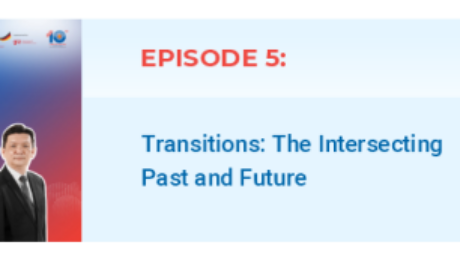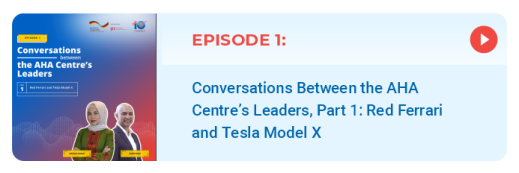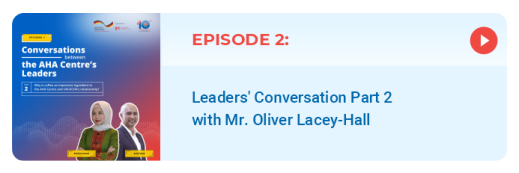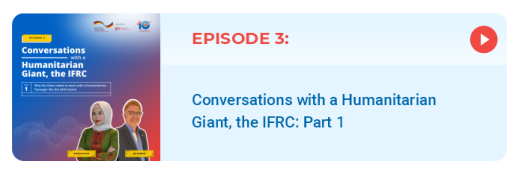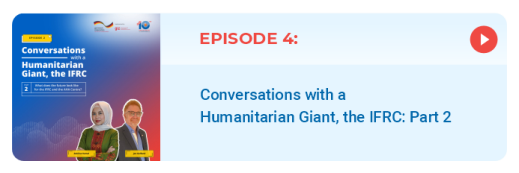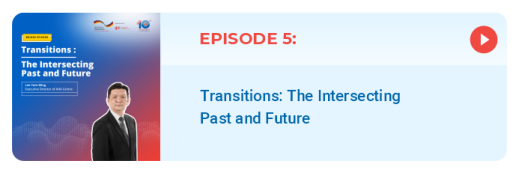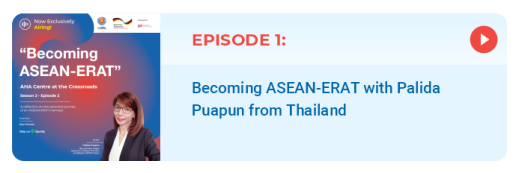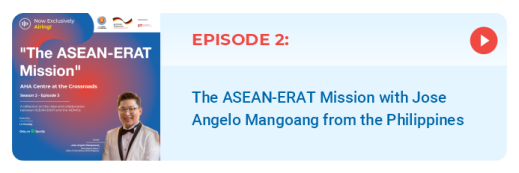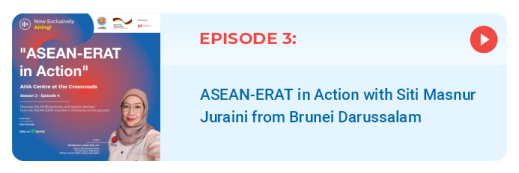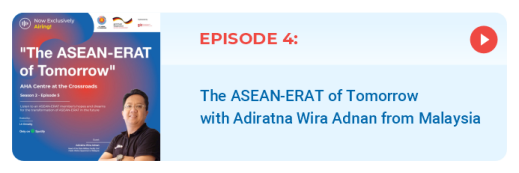Vol 84 – ASEAN-ERAT REFRESHER COURSE: PREPARING THE TEAM TO BE DEPLOYED IN ARDEX-23

ASEAN-ERAT REFRESHER COURSE: PREPARING THE TEAM TO BE DEPLOYED IN ARDEX-23
One of the important exercise players during the ASEAN Regional Disaster Response Simulation Exercise (ARDEX-23) is the ASEAN Emergency Response and Assessment Team (ASEAN-ERAT). As one of the region’s humanitarian actors, ASEAN-ERAT plays a significant role in supporting affected Member States during an emergency situation or in the event of a large-scale disaster.
In preparation for the deployment of ASEAN-ERAT to ARDEX-23, the AHA Centre organised the ASEAN-ERAT Refresher Course on 29-30 July 2023, with the aim to refresh knowledge and enhance the preparedness of ASEAN-ERAT members who will be deployed in the regional exercise. This 2-day course saw participation from ASEAN-ERAT members representing all 10 ASEAN Member States, the ASEAN Secretariat, and the AHA Centre.
In preparation for the deployment of ASEAN-ERAT to ARDEX-23, the AHA Centre organised the ASEAN-ERAT Refresher Course on 29-30 July 2023, with the aim to refresh knowledge and enhance the preparedness of ASEAN-ERAT members who will be deployed in the regional exercise. This 2-day course saw participation from ASEAN-ERAT members representing all 10 ASEAN Member States, the ASEAN Secretariat, and the AHA Centre.
Executive Director of the AHA Centre Mr. Lee Yam Ming highlighted the importance of the participation of ASEAN-ERAT members in ARDEX-23. It offers an invaluable opportunity for the Team to gain hands-on experience and learn in an environment that closely simulates real-life scenarios. “The course will also update ASEAN-ERAT members with the latest development of ASEAN disaster emergency response mechanism, tools, and recent deployment,” said Mr. Lee Yam Ming during the opening ceremony of the course.
Furthermore, Mr. Lee Yam Ming mentioned that during the refresher course, ASEAN-ERAT members will also have the opportunity to interact with the United Nations Disaster Assessment and Coordination (UNDAC), enabling them to learn about the interoperability between ASEAN-ERAT and UNDAC. In many disaster situations on the ground, ASEAN-ERAT and UNDAC frequently work together to provide support to the affected country. “This course will strengthen the common understanding that will contribute towards better interoperability between these organisations when working together within the region,” he added.
With the support from Japan-ASEAN Integration Fund (JAIF) and European Union Mission to ASEAN, this ASEAN-ERAT Refresher Course is designed with 20% theory and 80% hands-on learning, to enhance the capacities of ASEAN-ERAT Members in performing tasks, especially during the Table-top Exercise (TTX), Command Post Exercise (CPX) and Field Training/Simulation Exercise (FTX) in ARDEX-23. On 3 August 2023, ASEAN-ERAT members participated in the real CPX with the scenario of a 6.6 magnitude earthquake in Bantul, together with other exercise players of ARDEX-23.
Written by: Moch Syifa
- Published in AHA Centre Diary 1
Vol 84 – STRENGTHENING THE INSTITUTIONAL CAPACITY OF THE AHA CENTRE FOR ASEAN DISASTER CAPACITY BUILDING PROGRAMMES

STRENGTHENING THE INSTITUTIONAL CAPACITY OF THE AHA CENTRE FOR ASEAN DISASTER CAPACITY BUILDING PROGRAMMES
AHA Centre Work Plan 2025 envisions AHA Centre as an enabler for ASEAN to become a global leader in disaster management by 2025.
The ASEAN Vision 2025 on Disaster Management also outlines the expectations of ASEAN Member States for AHA Centre to “play a stronger role in facilitating capacity building to bring ASEAN Member States to regionally and globally recognized standards” as well as identifying AHA Centre’s potential to become “the network coordinator for regional centres for excellence for training and leadership in disaster management and emergency response and the engagement of the regional policy community” to nurture the next generation of leaders and thought leadership in ASEAN.
On 23 June 2022, Executive Director of AHA Centre, Lee Yam Ming and Ambassador of New Zealand to ASEAN, H.E. Stuart Donald Cave Calman launched AHA Centre’s partnership with New Zealand with a project titled “Strengthening the Institutional Capacity of the AHA Centre for ASEAN Disaster Capacity Building Programmes”. The partnership will focus on strengthening AHA Centre’s institutional capacity to provide world-class disaster management courses and capacity building programmes.
The 1st Project Steering Committee (PSC) Meeting was conducted online on 10 April 2023 to update the PSC members on the progress of the project. This included updates on impact study, roadmap, and Learning Management System (LMS).
IMPACT STUDY
Assessing the impact of the previous and existing ASEAN’s capacity building programmes on ASEAN and ASEAN Member Sates capacity and to evaluate the sustainability of the the impacts
ROADMAP
Will serve a comprehensive, concrete, and practical strategy for enhcancing ASEAN and ASEAN Member States capacities on disaster management for the period of 2023 – 2033
LMS
To maximise the impact and widen the coverage of the AHA Centre’s knowledge and outreach
Written by: Moch Syifa
- Published in Partnership
Vol 84 – GET TO KNOW ABOUT OPAK FAULT

GET TO KNOW ABOUT OPAK FAULT
Several geological studies have revealed that Southeast Asia is prone to earthquakes. This is inseparable from the fact that Southeast Asia is at the crossroads of three tectonic plates: the Pacific Ocean/Philippine Ocean Plate to the east, the Indo-Australian Plate to the south, and the Eurasian Plate to the northwest.
Opak Fault refers to a subsurface fault beneath the Opak River, 30 km southeast of Yogyakarta, and is covered by deposits of the young Mount Merapi, located in Bantul regency, southeast of Yogyakarta, within the southern Mount Merapi area. Early concerns about the existence of the Opak Fault arose when Dr. S. W. Visser reported an earthquake in Yogyakarta in 1867, with its epicenter located near the Opak River. It is also thought to have caused the formation of the Yogyakarta Basin, where the city of Yogyakarta is located.
The Opak Fault has an average depth of 55-82m, while its displacement ranges from 5-10m. Opak Fault is a normal fault that runs from southwest (SW) to northeast (NE); the west of the Opak Fault shows an uplift movement, while the east of the Opak Fault shows a subsidence movement. The fault runs through the Yogya Lowlands and the Wonosari Plateau, with old andesite rocks (OAF) as structural elements. This fault system also includes the Semilir Formation and the Nglanggran Formation to the east of Opak.
There is a significant surface deformation along the Opak Fault, which could be driven by the postseismic effect following the 2006 Yogyakarta earthquake or by aseismic creep. This long-term surface deformation can also affect various aspects of earthquake-affected land, including infrastructure and environmental damage.
The earthquake in Yogyakarta on 27 May 2006 was one of the worst disasters experienced by the people of Yogyakarta and Indonesia. Over 5,700 people were killed, 37,927 were injured, 240,396 homes were destroyed, and local infrastructure and economic activities were severely affected.
Located in the southern part of Java, Yogyakarta is prone to experiencing moderate to high-magnitude earthquakes (M > 6.0) with return periods of 50–100 years, making it one of Indonesia’s most seismically active cities. Of the 12 earthquakes in Yogyakarta from 1804-2006, three earthquakes, including the 2006 earthquake, were related to the movement of the Opak fault.
More recently, on 30 June 2023, Yogyakarta was hit by an earthquake measuring 5.8 (USGS) or 6.4 on the magnitude scale, although it only caused minor damage. This could also be attributed to the public’s preparedness and the strong structural integrity of buildings – lessons learned following the 2006 earthquake.
The position of the fault plane that cuts through the soil layer with a thickness of about 50 cm – 5 m indicates that this fault is active. Furthermore, the Opak Fault, which is still active, is increasingly showing signs of increased seismic activity based on BMKG monitoring. Communities around the Opak Fault often feel small earthquakes, or what they call “lindu”.
In addition, several areas traversed by the Opak Fault have high liquefaction potential. This is due to the geological environment in the form of alluvium deposits, groundwater table conditions, the path of the active Opak fault zone, and the Bantul basin (Bantul Graben).
Sustainable and resilient countermeasures are needed to deal with various potential disasters in a region historically prone to earthquake disasters, both in Yogyakarta and Southeast Asia. Therefore, the scenario of a 6.6 magnitude earthquake caused by the Opak Fault for the 2023 ASEAN REGIONAL DISASTER SIMULATION EXERCISE (ARDEX) offers a valuable opportunity for local and regional humanitarian actors to prepare for and respond to such a scenario, enhancing their readiness to mitigate the impact of such disasters effectively. The AHA Centre is pleased to participate in ARDEX-23, the ASEAN region’s biggest disaster and emergency response simulation exercise.
Sources
• BBC News Indonesia. (2023, August 5). BMKG Ingatkan Bahaya Sesar Opak, Warga Hanya Bisa Pasrah. kumparan. https://kumparan.com/bbc-news-indonesia/bmkg-ingatkan-bahaya-sesar-opak-warga-hanya-bisa-pasrah-20viEi4cfz3
• Cahyani, E., Afrita, W. N., Aza, A. E. N., & Sumunar, D. R. S. (2019). Pengembangan sistem jaringan evakuasi bencana likuifaksi di wilayah Sesar Opak. Geo Media: Majalah Ilmiah dan Informasi Kegeografian, 0(1).
• Dewanto, B. G., Setiawan, M. B., & Nusantara, G. C. (2020). Opak Fault Deformation Monitoring Using Sentinel-1 InSAR Data from 2016-2019 in Yogyakarta Indonesia. Elipsoida: Jurnal Geodesi dan Geomatika, 0(01), 46-54.
• Fathonah, I. M., Wibowo, N. B., & Sumardi, Y. (2014). Identifikasi Jalur Sesar Opak Berdasarkan Analisis Data Anomali Medan Magnet dan Geologi Regional Yogyakarta. Indonesian Journal Of Applied Physics, 0(02), 192-200.
• Prihatmaji, Y. P., Kitamori, A., & Komatsu, K. (2014). Traditional javanese wooden houses (Joglo) damaged by may 2006 Yogyakarta earthquake, Indonesia. International Journal of Architectural Heritage, 0(2), 247-268.
• Shah, A. A., Qadri, T., & Khwaja, S. (2018). Living with earthquake hazards in South and South East Asia. ASEAN Journal of Community Engagement, 2(1), 2.
• Sihombing, T. (2014). Perkembangan Elemen-Elemen Penting Tektonik Asia. Jurnal Geologi dan Sumberdaya Mineral, 4(2), 63-68.
• Sumartiningtyas, H. K. N. (2023, August 5). Mengenal Sesar Opak, Pusat GEMPA Yogyakarta 2006 halaman all. KOMPAS.com. https://www.kompas.com/sains/read/2023/08/05/093000323/mengenal-sesar-opak-pusat-gempa-yogyakarta-2006?page=all
• Sutiono, A., Prastistho, B., & Prasetyadi, C. (2018, December). Opak fault: a comparative review. In IOP Conference Series: Earth and Environmental Science (Vol. 212, No. 1, p. 012049). IOP Publishing.
• Pena-Castellnou, S., Steinritz, V., Marliyani, G. I., & Reicherter, K. (2021, October). Active tectonics of the Yogyakarta area (Central Java, Indonesia): preliminary findings obtained from a tectonic-geomorphic evaluation. In IOP Conference Series: Earth and Environmental Science (Vol. 851, No. 1, p. 012005). IOP Publishing.
• Prasetiyo, W. (2023, August 5). Lebih Jauh Soal Sesar Opak Dan potensi GEMPA Kuat di Yogyakarta. kumparan. https://kumparan.com/kumparannews/lebih-jauh-soal-sesar-opak-dan-potensi-gempa-kuat-di-yogyakarta-20vgpHD6DMJ
• Wijaksono, E. (2008). Pemodelan Tiga Dimensi (3D) Zona Sesar Opak Bantul Yogyakarta Berdasarkan Data Anomali Bouguer Lengkap.
Written by: M. Nadhif Achyansyah
- Published in Insight
Vol 84 – MONTHLY DISASTER REVIEW AND OUTLOOK

MONTHLY DISASTER REVIEW AND OUTLOOK
AUGUST 2023 | DISASTER MONITORING & ANALYSIS
(DMA) UNIT, AHA CENTRE
GENERAL REVIEW OF AUGUST 2023
For the month of August 2023, a total of 99 disasters were reported. The ASEAN Member States that were affected are Cambodia, Indonesia, Lao PDR, Myanmar, Philippines, Thailand, and Viet Nam. Most of the disasters (59.6%) occurred in Indonesia and accounted for 42.66% of the affected persons (around 1M persons) the second-highest number of affected persons for August 2023. The Philippines accounted for most of the affected persons despite reporting only 12 disaster events — the Effects of Southwest Monsoon enhanced by Tropical Cyclone SAOLA, Tropical Cyclone HAIKUI, and Tropical Cyclone YUN-YEUNG with 46% of the total reported affected persons for the month of August 2023. The share of the disaster-affected people for the other ASEAN Member States are as follows: (1) Philippines-47.32%, (2) Indonesia-42.66%, Lao PDR-3.99%, Myanmar-3.04%, Cambodia-2.53%, Viet Nam-0.35%, and Thailand 0.1%. August 2023 saw disasters affecting 347 per 100,000 people* and displacing 11 per 100,000 people* in the region, which were almost 2 times lower respectively compared to the previous month.
Most of the disasters that have occurred in August 2023 were floods (46.5%) which is occurred in the northern sides of the equatorial line and is consistently the most recorded type of disaster for August of the previous year and August on a five-year average (2018-2022). However, due to the effects of El Nino, droughts are the second-highest disaster report (28%) for August 2023, especially in the southern parts of the equatorial line (Indonesia). The reported disasters in the region for August 2023 in comparison to the historical data (average for August 2018-2022) indicates that there were about 1.3x more reported disasters; 1.6x more people affected; 1.7x less people internally displaced; 1.9x less houses affected to some extent; 2.4x more lives lost; and 1x equal people suffering injuries.
GEOPHYSICAL CONDITION FOR AUGUST 2023
Geophysically, 30 significant earthquakes (Magnitude ≥ 5.0) were reported by Indonesia’s Badan Meteorologi, Klimatologi dan Geofisika (BMKG) and the Philippine Institute for Volcanology and Seismology (PHIVOLCS) for the period of August 2023.
Mount Semeru (Alert Level ), Ili Lewotolok (alert Level ), Ibu (Alert Level ), and Dempo (Alert Level ) in Indonesia and Mayon (Alert Level 3), Taal (Alert Level 1), and Kanlaon Volcanoes (Alert Level 1) were reportedly tectonically active (erupting lava or releasing gas or generating seismic activity) throughout the month of August 2023.
As of 18 September PHIVOLCS maintained the Mayon Volcano Alert Level at Alert Level 3 (Increased Tendency Towards Hazardous Eruption). Mayon Volcano remains in a relatively high level of unrest as magma is at the crater and hazardous eruptions are possible within weeks or days. According to NDRRMC, as of 16 September 2023, 9.9K families (38.4K persons) have been affected and 13.6K persons remains internally displaced in 21 evacuation centres. The NDRRMC with other relevant-agencies/stakeholders have provided 7.7M USD worth of assistance to those affected.
*computed based on 2023 population data from worldometers.com
ANALYSIS
According to the ASEAN Specialised Meteorological Centre (ASMC), compared to the average value from 2001-2022, during August 2023, below-average rainfall was experienced in the central and southern parts of the Mainland Southeast Asia, and southern half of the Maritime Continent, while a mix of below-to above-average rainfall was experienced over the rest of the ASEAN region. The largest positive (wetter) anomalies were recorded over parts of western Myanmar, the largest negative (drier) anomalies were recorded over parts of Cambodia and southern Sumatra, parts of the Maluku Islands and southern Papua as shown in Figure 1. Particularly for the wetter conditions in the Philippines as shown in Figure 1, a MAJOR disaster was caused by the Effects of Southwest Monsoon enhanced by Tropical Cyclone SAOLA, Tropical Cyclone HAIKUI, and Tropical Cyclone YUN-YEUNG.
SEASONAL OUTLOOK
According to the ASEAN Specialised Meteorological Centre (ASMC), Southwest Monsoon conditions were observed in August 2023 and are expected to transition to the inter-monsoon period in the latter part of October 2023. These conditions traditionally bring light and variable winds and increased shower activities in the equatorial region as the monsoon rain-band shifts southwards into the region.
For the next 3 months, (September-October-November 2023), an increased chance of below-normal rainfall is predicted for most of the southern ASEAN region, extending to include the Philippines. El Niño conditions are predicted to strengthen and a positive Indian Ocean Dipole (IOD) is likely to develop in September 2023. Both El Niño conditions and positive IODs tend to bring drier conditions to parts of the ASEAN region. Above-normal temperature is predicted for most of the ASEAN region for September-October-November 2023.
Note: The qualitative outlook is assessed for the region in general and based on the latest runs from models provided by the SEA RCC-Network LRF node. For specific updates on the national scale, the relevant ASEAN National Meteorological and Hydrological Services should be consulted.
Sources: ASEAN Disaster Information Network (ADINet), ASEAN Disaster Monitoring and Response System (DMRS), ASEAN Specialised Meteorological Centre (ASMC), Badan Nasional Penanggulangan Bencana (BNPB) – Indonesia, Agensi Pengurusan Bencana Negara (NADMA) – Malaysia, Department of Disaster Management (DDM) – Myanmar, National Disaster Risk Reduction and Management Council (NDRRMC) – Philippines, Department of Disaster Prevention and Mitigation (DDPM) – Thailand, Thai Meteorological Department (TMD) – TMD, Badan Meteorologi, Klimatologi dan Geofisika (BMKG) – Indonesia, Pusat Vulkanologi dan Mitigasi Bencana Geologi (PVMBG) – Indonesia, Philippine Institute for Volcanology and Seismology (PHIVOLCS) – Philippines, Philippine Atmospheric Geophysical and Astronomical Services Administration (PAGASA) – Philippines
Written by : Keith Paolo Landicho, Sadhu Zukhruf Janottama, Lawrence Anthony Dimailig
DISCLAIMER
The AHA Centre’s estimation is based on data and information shared by National Disaster Management Organisations (NDMOs) and other relevant agencies from ASEAN Member States, international organisations, and news agencies. Further information on each recorded significant disaster, description, and detail of data and information are available at: https://adinet.ahacentre.org/report/
- Published in Monthly Disaster Outlook
Vol 84 – ARDEX-23: STRENGTHENING ASEAN’S COLLECTIVE RESPONSE CAPACITY

ARDEX-23 :
STRENGTHENING ASEAN’S COLLECTIVE RESPONSE CAPACITY
Hundreds of disaster management and humanitarian actors from 10 ASEAN Member States and other countries gathered in Yogyakarta, Indonesia, to witness the biggest disaster emergency response simulation exercise in the region, namely ARDEX.
ARDEX is the only regional exercise platform that tests and validates disaster management tools to improve preparedness and readiness for One ASEAN One Response. The results of the 3-day exercise acted as the catalyst for improvements and changes to many of these processes, including updating and refining the Standard Operating Procedure for Regional Standby Arrangements and Coordination of Joint Disaster Relief and Emergency Response Operations (SASOP). ARDEX-23 also presented the opportunity to engage bodies from both outside the direct disaster management scope, as well as outside the region, to further understand and increase implementation capacity of ASEAN disaster management process and practice, a particularly important element for efficient responses to large-scale disasters.
Deputy Secretary-General of ASEAN for ASEAN Socio-Cultural Community H.E. Ekkaphab Phanthavong highlighted three important points aspects of ARDEX. First, ARDEX is crucial as it showcases that ASEAN is ablilitye to operate collectively as one in the event of a large-scale disaster in the region. Second, ARDEX is also vital for to testing all the components and elements in the ASEAN SOPs, including the role of the ASEAN Secretary-General of ASEAN as the ASEAN Humanitarian Assistance Coordinator or SG-AHAC. “Lastly, ARDEX is indeed useful in demonstrating the ASEAN solidarity to our global partners. It offers our partners the opportunity to witness the ASEAN collective response as well as to understand the ASEAN disaster management mechanism,” he said during the opening ceremony of ARDEX-23.
The Special Region of Yogyakarta was chosen as the location of ARDEX-23 as this region previously experienced a 6.5M earthquake in 2006 caused by the Opak Fault. By having ARDEX-23 in Yogyakarta, it is expected to also enhance the local and national capacity in the preparedness and response in case of a large-scale disaster hit in the area. “Yogyakarta also has its local wisdoms and experiences in managing disasters. This [ARDEX] will be a good opportunity to share these experiences with the ASEAN Member States,” added Head of the Indonesian National Disaster Management Authority (BNPB) Lieutenant General TNI Suharyanto in his opening speech.
Through ARDEX, he added, Indonesia and the ASEAN Member States is able to facilitate the transfer of knowledge and good practices on disaster management. It is also expected to build a foster coordination between civil and military entities in responding to disasters and to build solidarity under the spirit of One ASEAN One Response.
ARDEX-23 was conducted on 1-3 August 2023 with a combination of both strategic and tactical components, with the simulation exercise including indoor tabletop exercise (TTX) discussions between decision makers, in parallel with outdoor command post exercises (CPX) and joint field training exercises (FTX) for humanitarian responders. The scenario of ARDEX-23 is a 6.6 magnitude earthquake with the epicentre in Bantul, Yogyakarta. Over 180 players, planners, referees, and observers from 10 ASEAN Member States and partners of the AHA Centre participated, and with more than 500 participants from local and national levels involved in the exercise.
The opening ceremony was attended by the Coordinating Minister for Human Development and Cultural Affairs of the Republic of Indonesia H.E. Prof. Dr. Muhadjir Effendi, Head of BNPB Indonesia Lieutenant General TNI Suharyanto, Deputy Secretary-General of ASEAN for ASEAN Socio-Cultural Community H.E. Ekkaphab Phantavhong, representatives from the 10 ASEAN Member States, partners, and participants from local and national levels.
ARDEX-23
• Held in Yogyakarta, 1-3 August 2023
• Scenario of M6.6 Bantul earthquake
• 180 participants from ASEAN Member States and partners of the AHA Centre
• 500+ participants from local and nantional levels
• Second ARDEX hosted by Indonesia after ARDEX-18 in Cilegon, Banten 2018
Written by: Moch Syifa, Gladys Respati | Photo by: AHA Centre
- Published in Highlight
Vol 82 – FROM SEOUL TO SEJONG : AN ENJOYABLE INTERNSHIP IN SOUTH KOREA

FROM SEOUL TO SEJONG :
AN ENJOYABLE INTERNSHIP IN SOUTH KOREA
November 2022 marked the end of my internship with the ASCEND (ASEAN Standards and Certification for Experts in Disaster Management) project at the AHA Centre. I completed my internship while studying for a Master’s degree in the Civil Society Leadership program at Ajou University, Suwon, South Korea. It is one of the scholarship programs held by KOICA (Korea International Cooperation Agency) under the 2021 Technical Cooperation Program of the Government of the Republic of Korea. Spending almost two years of studying and simultaneously interning in South Korea has been a valuable opportunity to experience what it feels like to work in Korea.
Interning at the AHA Centre feels like I am coming home. I joined as an ASEAN-ERAT member in 2017 and have been deployed on humanitarian missions by the AHA Centre. I have also been involved in some of the ACE programme activities, as a facilitator during the Red Cross Red Crescent Induction Course, and have been invited to join some of the international events. Therefore, when I saw the internship opportunity with the ASCEND project, I immediately applied for it.
The distance of more than 5,000 km between Jakarta, Indonesia and Suwon, South Korea, has made the internship more interesting. Due to the COVID-19 pandemic, having online meetings is no longer a new activity for everyone. I am very much grateful for all the support given to me by the immediate supervisor and other colleagues in the ASCEND program. The working environment is friendly and supportive.
Assisting in the ASCEND Benchmarking Visit to South Korea from 26 to 30 September 2022 was also part of the internship. During the visit, participants from the ASEAN Member States came to Korea to gain in-depth knowledge of how the Republic of Korea responds in emergency situations. We also had the opportunity to learn how the Korea National Fire Agency operates. Again, the visit gave me the opportunity to expand my knowledge during the internship. The field visits were one of the most exciting things, since it gave me the chance to participate in offline activities after Covid-19 restrictions. Visiting places from Sejong to Seoul during the Benchmarking Visit was particularly thrilling, especially places that I may not have been able to visit as a student. For example, visiting the KNFA Fire Academy, Seoul Emergency Operation Center, and many more. Seeing the working places related to emergency response in Korea provided me with insights into how South Korea has transformed from a developing country to a progressive developed country.
Again, this internship has given me a broader perspective on working in an international environment, especially in South Korea. However, I do feel something is still incomplete, since my Korean language skills are still limited. Otherwise, I believe I could have contributed more to this internship. As I mentioned earlier, I have had several experiences working with the AHA Centre in Indonesia and on international missions. This internship has added even more value, and it feels like I was being prepared to return to work again after graduation in January 2023.
“Thank you, AHA Centre, the ASCEND Project, and the ASEAN Korea Cooperation Fund, for this valuable opportunity. I am very much looking forward to having more working opportunities with the AHA Centre.”
Written by: Andreane Tampubolon, ASCEND Intern
- Published in The Other Side
Vol 82 – INTERNSHIP STORY: AULIA DARA NUR ARIFIN

INTERNSHIP STORY:
AULIA DARA NUR ARIFIN
My name is Aulia Dara Nur Arifin (Dara), and I first discovered the AHA Centre many years ago when I was a fresh graduate looking for a job. Being involved with a humanitarian or development organisation has always been my goal, so I bookmarked the AHA Centre’s vacancy page, and it has remained there ever since.
Years passed, and after a somewhat life-altering decision to resign from my previous job and enrol for a master’s degree in Social Welfare, I visited that page again and was delighted to find a vacancy for an internship with the ASEAN Standards and Certification for Experts in Disaster Management (ASCEND) Project, which I applied for in a heartbeat.
Long story short, I received an acceptance email during one of my classes, which luckily was online; otherwise, I would have to excuse myself to express my excitement. Thus began the 6-month-journey of my internship at the AHA Centre.
Previously working in a profit industry and being out of touch with a humanitarian environment made me wary, and I questioned myself numerous times if I could be of help to the project, especially since it focuses on the certification process for disaster management, an area I was eager to learn about but was far from understanding. I was very glad this thought was immediately shattered as the team, consisting of Mas Andrew, Excel and Kak Haura, guided me thoroughly. They not only introduced the project and my responsibilities and tasks within this internship, but also explained how a regional organisation/project operates, maintain its relationship with Member States and other stakeholders, as well as how they carry out their mission through various projects within the AHA Centre.
Not long after I joined, I was greeted with ASCEND’s first project, which was the first Assessor Training in Viet Nam, exposing me firsthand to a regional project’s preparation prior to an event. Although I didn’t attend the training myself, I had a very strong sense of belonging as I was included in every step of the event, an amenity I continued to feel throughout my internship period. Soon after this event concluded, I was greeted with the project’s next event, which was the Benchmarking Visit to the Republic of Korea. Even though the logistical and administrative work were similar to the previous event, the objective was different, and I got to be more involved in the development of its handbook to facilitate the visit.
Upon completing the Benchmarking Visit, I was again greeted by the project’s final big event of the year, the ASCEND Certification Trial Simulation and Evaluation Workshop. It was around this time that my understanding of the project and its objectives became more solid. The prior activities, such as the Assessor Training, the development of the toolbox and its competency standards, as well as the continuous efforts to improve the process through discussions with relevant parties, served as significant steps for this event. My responsibilities grew more diverse, and I was glad to carry out different tasks and become more involved in its logistical and administrative work, which proved to be a crucial process to ensure smooth implementation. I was very delighted and proud to end my internship with such an inspiring event and had the chance of working alongside hard-working, kind, and supportive people.
If I had to describe my internship experience using one word, it would be FUN. The word itself is often associated with an easy-going picture of life, but for me, through what seemed like a roller coaster ride and quakes (literally) of lessons and experiences, I was able to enjoy every second of it and still crave more. Balancing my studies with my internship was challenging, but the ASCEND Project Management Team (PMT) made it easy and was very supportive as they provided me with the flexibility to attend and focus on both without jeopardising the other. This was also the word I used to describe ASCEND’s fifth Project Steering Committee (PSC) Meeting, an occasion I was honoured to be involved in and attend, which provided me with knowledge on how regional forums are conducted, and I was also very impressed to learn a new language. English was spoken – however, I realised how communications used within this setting is always geared towards positivity and encouragement, a significant tool to achieve collective development and progress, which resulted in fruitful discussions and inputs.
People go through different experiences to understand and find meaning in the work they do, and for me, this internship brought it back from a deep slumber. It was here that I discovered how my studies are not just a shortcut to improve someone’s social welfare or achieve a better quality of life. It is an elaborate and comprehensive process of planning, identifying issues and potentials, designing growth and development strategies, and having a well-thought-out implementation and evaluation and monitoring process of its activities and objectives to achieve social welfare as its ultimate goal. For the ASCEND project, the goal is improving people’s lives by providing competent experts and professionals to facilitate disaster management activities. It has shown me that social change takes time because the goal is the development of human capital through capacity building, a valuable investment for the people, which I was very fortunate to be able to witness and experience through my internship for the ASCEND Project at the AHA Centre.
Written by: Aulia Dara Nur Arifin, ASCEND Intern
- Published in The Other Side
Vol 82 – THE ASEAN-ERAT LEVEL 3 (TEAM LEADER) PILOT COURSE

THE ASEAN-ERAT LEVEL 3 (TEAM LEADER) PILOT COURSE
Equipping Leaders for Effective Emergency Response
The ASEAN-ERAT Level 3 (Team Leader) Pilot Course was held in Bogor, Indonesia, from 8 to 15 May 2023 with the support of the Government of Japan through the Japan-ASEAN Integration Fund (JAIF). Hosted by the Indonesian National Disaster Management Authority (BNPB), the Pilot Course was attended by 11 experienced ASEAN-ERAT Members from Cambodia, Indonesia, Lao PDR, Malaysia, Myanmar, Singapore, Viet Nam, and the AHA Centre.
Strengthening the ASEAN-ERAT System for Disaster Response
Since its establishment in 2008, the ASEAN Emergency Response and Assessment Team (ASEAN-ERAT) has been deployed to numerous emergency response missions across seven countries in the region. The team has played a pivotal role in providing leadership and coordination services during emergencies, contributing to ASEAN centrality in times of crisis.
In order to strengthen the ASEAN-ERAT system for disaster preparedness and response in line with the ASEAN Vision 2025, the ASEAN-ERAT personnel capacity-building has been focused at three levels: In-Country Team (Level 1), Specialist (Level 2), and Team Leader (Level 3). To achieve this, the AHA Centre has conducted several advanced courses, including rapid needs assessment, information management, humanitarian logistics, humanitarian civil-military coordination, and early recovery assessment.
The ASEAN-ERAT Level 3 (Team Leader) Pilot Course marks a significant milestone in the continuous strengthening of ASEAN-ERAT. As the frequency and severity of natural disasters in the region increase, the need for a well-trained and capable response team becomes ever more crucial. Thus, the ASEAN-ERAT Level 3 course aimed to develop experienced humanitarian response leaders with strong leadership skills who can assume authority and lead ASEAN response operations on the ground.
A customised course curriculum for Team Leaders was developed to address the specific needs and context of the ASEAN-ERAT. The curriculum focuses on teaching nine essential leadership traits, including Command and Control, Knowledge in Disaster Management, Negotiation Skills, Presentation Skills, Communication, Coordination, Reporting to the AHA Centre, and Financial Management.
Building Skills and Testing Leadership
At the Closing Ceremony of the ASEAN-ERAT Level 3 Pilot Course, Executive Director of the AHA Centre Mr. Lee Yam Ming congratulated the participants for being the first batch of ASEAN-ERAT Members to be trained as future Team Leaders. He expressed his hope that participants would continue to lend their strength to the ASEAN-ERAT within and beyond the ASEAN region. “Not only by responding to the call for deployment and leading ASEAN-ERAT in the field, but by also guiding and nurturing future ERAT Team Leaders and Members as role models and mentors,” he added.
Participants of the ASEAN-ERAT Level 3 (Team Leader) Pilot Course themselves found the course to be a great opportunity to gain new skills and prepare for the realities of leading a team on the field. “The best thing is that there is a lot of emphasis and focus on the soft skills element of leadership,” said Ihsan Fauzano, an ASEAN-ERAT Member from Indonesia who participated in the Pilot Course. “We learned communication, negotiation, decision making, team dynamics, delegating. And for the last 3 days, we learned stress management and time management during the Simulation Exercise.”
Dr. Janaki Rani, an ASEAN-ERAT Batch 8 member from Malaysia, added that the training of ASEAN-ERAT Team Leaders is crucial to ensure a successful mission. “The outcome of the mission would be better when we train leaders who are capable of handling the entire team, produce good reports, and can give good information that helps the AHA Centre and affected Member States to make good decisions, leading to an effective disaster response,” said Dr. Janaki.
The ASEAN-ERAT Level 3 (Team Leader) Pilot Course represents a significant step in strengthening the ASEAN-ERAT’s ability to respond effectively to natural disasters. By developing competent and experienced team leaders, ASEAN-ERAT aims to enhance its coordination and leadership services during emergencies. The course not only equips participants with essential skills and knowledge but also fosters a network of capable leaders who will guide and nurture future ASEAN-ERAT team members. With continued support from partners and a commitment to continuous improvement, ASEAN-ERAT is well-positioned to meet the challenges posed by the increasing occurrence of natural disasters in the region.
Written by: Gladys Respati, Madiatri Silalahi, Anggaripeni Mustikasiwi | Photo credit: AHA Centre
- Published in AHA Centre Diary 1
Vol 82 – BUILDING RESILIENCE OF WOMEN AND OTHER VULNERABLE GROUPS THROUGH CAPACITY BUILDING

BUILDING RESILIENCE
OF WOMEN AND OTHER VULNERABLE GROUPS THROUGH CAPACITY BUILDING
Background of the Project
The project ‘Improving ASEAN’s Humanitarian Assistance Capacity in Multi Hazard’ – funded by the Government of Canada (Global Affairs’ Canada) – launched in April 2022, will run for five years, from 2022 – 2027.
One of the guiding principles of the ASEAN Agreement on Disaster Management and Emergency Response (AADMER) Work Programme 2021 – 2025 is on Gender and Inclusion. This principle inculcates a whole-of-society approach in disaster management that leaves no one behind by recognizing the key roles and unique needs of the communities, especially those that are most affected during disasters, including women and other vulnerable groups. As one of the implementors of the AADMER Work Programme 2021 – 2025, the AHA Centre proposed this project to further expand the capacity of ASEAN Member States and Local Partners through a multi-sectoral approach to systematically integrate such gender and protection considerations into disaster management.
Through this project, the AHA Centre supports ASEAN Member States and Local Partners to recognize and set the priorities for indicators and targets related to protection, gender, and inclusiveness (PGI). This project believes that building resilience of women, and other vulnerable groups within the national and regional resilience will help in addressing and mitigating socio-economic impact of the disasters.
The Project adopts the AADMER Work Programme 2021-2025 and formulized the ASEAN Regional Framework on Protection, Gender, and Inclusion in the ASEAN Region. Subsequently, a new AADMER Technical Working Group on Protection, Gender, and Inclusion (TWG-PGI) was established in 2021 to support the mainstreaming of the gender and social inclusion guiding principles throughout the disaster management efforts in the region.
Main Components of the Project
The Project has three main components, among others, (i) Enhanced Regional Coordination Mechanism to respond to multiple types of disasters, which integrates PGI, Climate Change Adaptation and Environmental Sustainability measures; (ii) Improved Knowledge of ASEAN responders in addressing the needs and interests of vulnerable groups during emergency periods; and (iii) Improved disaster management and emergency response practices in ASEAN Member States.
Upcoming activities of 2023
As of February 2023,
the Canada Project had its first series of activities—Exchange Forum on ASEAN’s Practices on Data Disaggregation in Disaster Management: A Way Towards Protection, Gender, and Inclusiveness (PGI), and the 1st Project Steering Committee (PSC) Meeting of the Project, which were held in Da Nang, Viet Nam on 22-24 February 2023. The PGI Exchange Forum is designed to help participants exchange knowledge on PGI experiences, which will be a key principle for the achievement of this project. The PGI Exchange Forum and the 1st PSC Meeting were held back-to-back with the 5th Meeting of the Technical Working Group on Protection, Gender and Inclusion (TWG-PGI), and 5th Meeting of the ASEAN Committee on Disaster Management Working Group on Prevention and Mitigation (ACDM WG P&M).
Starting Quarter 2 of 2023 (April – June),
the project aims to conduct Consultation and Desk Review on expanding the existing New Risk Scenario. This activity falls under the outcome of “Enhancing Regional Coordination Mechanism to respond to multiple types of disaster which integrates PGI, Climate Change Adaptation and Sustainability measures”. Within this activity, the project aims to develop a new Disaster Risk Scenario Study, adding to the three existing scenarios in the ASEAN Joint Disaster Response Plan (AJDRP). The new Disaster Risk Scenario will focus on Transboundary Flood within the Mekong sub-region. Additionally, the scenario will integrate PGI, Climate Change Adaptation and Environmental Sustainability as part of the Project’s key thematic areas.
In Quarter 3 of 2023 (July – August),
the project intends to organize consultation workshops to validate the New Risk Scenario. Within the same quarter, the project further aims to conduct Capacity Building on PGI, focusing on the exchange of experiences among ASEAN Member States through cross-learning.
In the last Quarter 4 of 2024 (October – December),
the project aims to deploy experts from the Member States to other Member States as part of Capacity Development Support.
Canada’s Support
The Project Management Team has been recruited in Jakarta, Indonesia, and have begun their work alongside the Disaster Monitoring & Analysis Team (DMA) in the AHA Centre. The Team is currently made up of a Project Officer and Project Assistant, who will implement the project’s activities and strategy with support from the Government of Canada and experts from the AHA Centre’s partners, including UNWOMEN, LACER, and SDC.
This forms an exciting journey for the AHA Centre and the ASEAN Member States to ensure this initiative further contributes to the envisions of AADMER Work Programme 2021-2025. The AHA Centre, through the Canada-funded project, looks forward to working closely with the Government of Canada, NDMOs, ASEAN Member States, The ASEAN Secretariat, and AHA Centre partners, to integrate PGI, CCA, and ES into the efforts of increasing capacity, enhancing standby arrangement with new disaster scenario, and further increasing collaboration and partnership will increase resiliency of multiple types of disasters within AMS and Local Partners.
Written by: Pwint Mon Swe, Htet Wai Zin, Lawrence Anthony Dimailig
- Published in Partnership
Vol 82 – AHA CENTRE PODCAST SERIES: AT THE CROSSROADS

AHA CENTRE PODCAST SERIES:
AT THE CROSSROADS
The AHA Centre, with support from Deutsche Gesellschaft für Internationale Zusammenarbeit GmbH (GIZ), worked to broaden its communications and outreach, including on social media. One of the results of this cooperation was a series of podcasts released in mid-2021 as part of the AHA Centre’s 10th Anniversary celebration. The podcast series entitled “AHA Centre at the Crossroads” involved discussions with the AHA Centre’s founders, builders, colleagues and partners, and discussed the AHA Centre’s 10-year journey from inception to transition. The guests described their experiences in working together with the Centre and expressed their hopes for the future in the next decade of action.
The first season is already airing and accessible at the AHA Centre’s Spotify channel – AHA Centre at the Crossroads. Meanwhile, the second season focused on sharing experiences from members of the ASEAN Emergency Response and Assessment Team (ASEAN-ERAT) as ASEAN’s rapid response team and was released in February 2023.
In the second season, four ASEAN-ERAT members from Thailand, Philippines, Brunei Darussalam, and Malaysia shared their experiences of becoming ASEAN-ERAT members, particularly when the were deployed to the disaster affected countries. Being deployed to different countries has always been a challenge for them. Not only conducting rapid needs assessment in the affected areas, but the ASEAN-ERAT members also need to understand the culture and other social aspects.
The AHA Centre Podcast has become an alternative channel for the AHA Centre to communicate to its partners and stakeholders on various topics in this digital era.
SEASON 1
SEASON 2
Written by: Moch Syifa
- Published in Insight





























